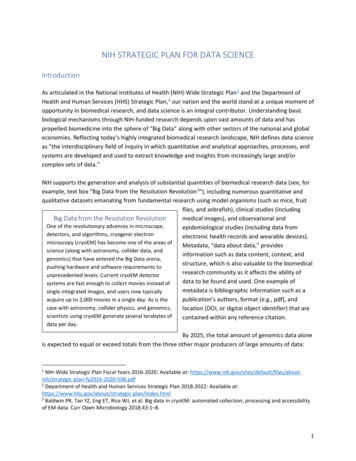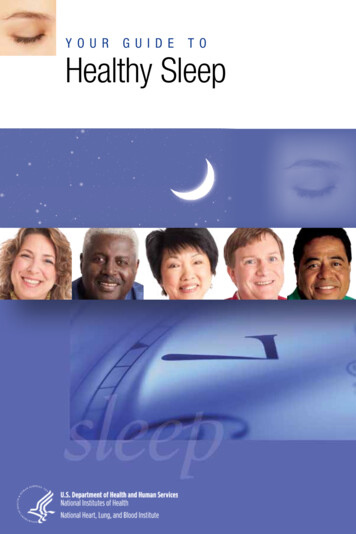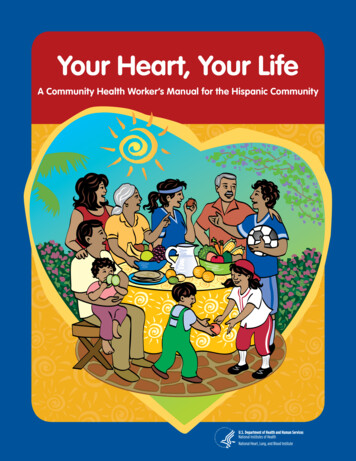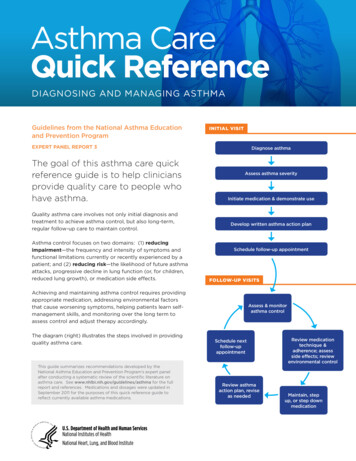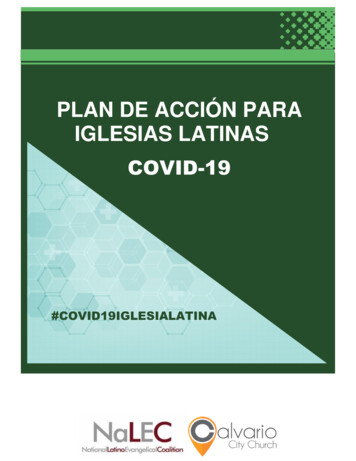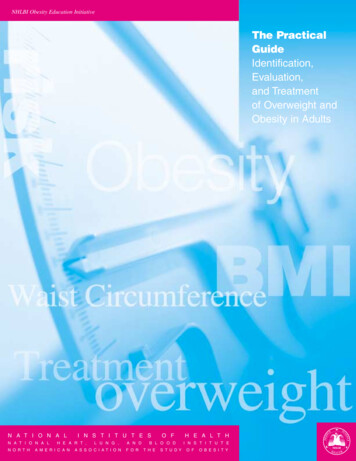
Transcription
NHLBI Obesity Education InitiativeThe PracticalGuideIdentification,Evaluation,and Treatmentof Overweight andObesity in AdultsNN AA T T I I OO NN AA L LI I NN SS T T I I T T UU T T EE SSOO F FHH EE AA L L T T HHN NA AT TI IO ON NA AL L H HE EA AR RT T, , L LU UN NG G, , A AN ND D B BL LO OO OD D I IN NS ST TI IT TU UT TE EN O R T H A M E R I C A N A S S O C I AT I O N F O R T H E S T U DY O F O B E S I T Y
ACKNOWLEDGMENTS:The Working Group wishes to acknowledgethe additional input to the Practical Guide fromthe following individuals: Dr. Thomas Wadden,University of Pennsylvania; Dr. Walter Pories,East Carolina University; Dr. Steven Blair,Cooper Institute for Aerobics Research; andDr. Van S. Hubbard, National Institute ofDiabetes and Digestive and Kidney Diseases.
The PracticalGuideIdentification,Evaluation,and Treatmentof Overweight andObesity in AdultsNational Institutes of HealthNHLBI Obesity Education InitiativeNational Heart, Lung, and Blood InstituteNorth American Association for the Study of ObesityNIH Publication Number 00-4084October 2000
NHLBI Obesity Education InitiativeExpert Panel on the Identification,Evaluation, and Treatment ofOverweight and Obesity in Adults.Barbara C. Hansen, Ph.D.University of Maryland School of MedicineDavid F. Williamson, Ph.D., M.S.Centers for Disease Control and PreventionMillicent Higgins, M.D.University of MichiganG. Terence Wilson, Ph.D.Rutgers Eating Disorders ClinicF.Xavier Pi-Sunyer, M.D., M.P.H.Columbia University Collegeof Physicians and SurgeonsChair of the PanelJames O. Hill, Ph.D.University of ColoradoHealth Sciences CenterEX-OFFICIO MEMBERSMEMBERSDiane M. Becker, Sc.D., M.P.H.The Johns Hopkins UniversityRobert J. Kuczmarski, Dr.P.H., R.D.National Center for Health StatisticsCenters for Disease Control and PreventionClaude Bouchard, Ph.D.Laval UniversityShiriki Kumanyika, Ph.D., R.D., M.P.H.The University of PennsylvaniaKaren A. Donato, M.S., R.D.*Executive Director of the PanelCoordinator, NHLBI ObesityEducation InitiativeNational Heart, Lung, and Blood InstituteNational Institutes of HealthRichard A. Carleton, M.D.Brown University School of MedicineR. Dee Legako, M.D.Prime Care Canyon ParkFamily Physicians, Inc.Nancy Ernst, Ph.D., R.D.*National Heart, Lung, and Blood InstituteNational Institutes of HealthT. Elaine Prewitt, Dr.P.H., R.D.Loyola University Medical CenterD. Robin Hill, Ph.D.*National Heart, Lung, and Blood InstituteNational Institutes of HealthGraham A. Colditz, M.D., Dr.P.H.Harvard Medical SchoolWilliam H. Dietz, M.D., Ph.D.National Center for Chronic DiseasePrevention and Health PromotionCenters for Disease Control and PreventionBarbara V. Howard, Ph.D.Medlantic Research InstituteAlbert P. Rocchini, M.D.University of Michigan Medical CenterJohn P. Foreyt, Ph.D.Baylor College of MedicinePhilip L Smith, M.D.The Johns Hopkins Asthmaand Allergy CenterRobert J. Garrison, Ph.D.University of Tennessee, MemphisLinda G. Snetselaar, Ph.D., R.D.University of IowaScott M. Grundy, M.D., Ph.D.University of Texas SouthwesternMedical Center at DallasJames R. Sowers, M.D.Wayne State University School of MedicineUniversity Health CenterMichael Weintraub, M.D.Food and Drug AdministrationNorth American Association for theStudy of Obesity Practical GuideDevelopment CommitteeLouis J. Aronne, M.D., F.A.C.P.Cornell University, ChairMEMBERSCharles Billington, M.D.University of MinnesotaGeorge Blackburn, M.D., Ph.D.Harvard UniversityKaren A. Donato, M.S., R. D.NHLBI Obesity Education InitiativeNational Heart, Lung, andBlood InstituteNational Institutes of HealthArthur Frank, M.D.George Washington UniversitySusan Fried, Ph.D.Rutgers UniversityPatrick Mahlen O'Neil, Ph.D.Medical University of South CarolinaHenry Buchwald, M.D.University of MinnesotaGeorge Cowan, M.D.University of TennesseeCollege of MedicineRobert Brolin, M.D.UMDNJ-Robert Wood JohnsonMedical SchoolEX-OFFICIO MEMBERSJames O. Hill, Ph.D.University of ColoradoHealth Sciences CenterEdward Bernstein, M.P.H.North American Associationfor the Study of ObesityClarice D. Brown, M.S.Coda Research Inc.Michael J. Horan, M.D., Sc.M.*National Heart, Lung, and Blood InstituteNational Institutes of HealthVan S. Hubbard, M.D., Ph.D.National Institute of Diabetes andDigestive and Kidney DiseasesJames P. Kiley, Ph.D.*National Heart, Lung, and Blood InstituteNational Institutes of HealthEva Obarzanek, Ph.D., R.D., M.P.H.*National Heart, Lung, and Blood InstituteNational Institutes of Health*NHLBI Obesity Initiative Task Force MemberCONSULTANTDavid Schriger, M.D., M.P.H., F.A.C.E.P.University of CaliforniaLos Angeles School of MedicineSAN ANTONIO COCHRANE CENTERElaine Chiquette, Pharm.D.Cynthia Mulrow, M.D., M.Sc.V.A. Cochrane Center at San AntonioAudie L. Murphy MemorialVeterans HospitalSTAFFAdrienne Blount, Maureen Harris, M.S., R.D.,Anna Hodgson, M.A., Pat Moriarty, M.Ed.,R.D., R.O.W. Sciences, Inc.
Table of ContentsForeword .vHow To Use This Guide .viExecutive Summary .1Assessment .1Body Mass Index.1Waist Circumference .1Risk Factors or Comorbidities .1Readiness To Lose Weight.2Management.2Weight Loss .2Prevention of Weight Gain .2Therapies.2Dietary Therapy.2Physical Activity .3Behavior Therapy .3Pharmacotherapy .3Weight Loss Surgery.4Special Situations.4Introduction.5The Problem of Overweight and Obesity .5Treatment Guidelines .7Assessment and Classification of Overweight and Obesity .8Assessment of Risk Status .11Evaluation and Treatment Strategy .15Ready or Not: Predicting Weight Loss .21Management of Overweight and Obesity.23Weight Management Techniques .25Dietary Therapy .26Physical Activity.28Behavior Therapy .30Making the Most of the Patient Visit.30Pharmacotherapy .35Weight Loss Surgery .38Weight Reduction After Age 65 .41References .42iii
Introduction to the Appendices .45Appendix A. Body Mass Index Table.46Appendix B. Shopping—What to Look For .47Appendix C. Low Calorie, Lower Fat Alternatives.49Appendix D. Sample Reduced Calorie Menus.51Appendix E. Food Exchange List.57Appendix F. Food Preparation—What to Do .59Appendix G. Dining Out—How To Choose.60Appendix H. Guide to Physical Activity .62Appendix I. Guide to Behavior Change .68Appendix J. Weight and Goal Record .71Appendix K. Weekly Food and Activity Diary.74Appendix L. Additional Resources.75List of TablesTable 1.Table 2.TableTableTableTable3.4.5.6.List of FiguresFigure 1.Figure 2.Figure 3.Figure 4.Figure 5.ivClassifications for BMI .1Classification of Overweight and Obesity by BMI, Waist Circumference,and Associated Disease Risk.10A Guide to Selecting Treatment.25Low-Calorie Step I Diet .27Examples of Moderate Amounts of Physical Activity .29Weight Loss Drugs .36Age-Adjusted Prevalence of Overweight (BMI 25–29.9) andObesity (BMI 30) .6NHANES III Age-Adjusted Prevalence of High Blood Pressure (HBP),High Total Blood Cholesterol (TBC), and Low-HDL by Two BMI Categories .6Measuring-Tape Position for Waist (Abdominal) Circumference in Adults .9Treatment Algorithm .16Surgical Procedures in Current Use.38
Forewordn June 1998, the Clinical Guidelines on theIdentification, Evaluation, and Treatment ofOverweight and Obesity in Adults: EvidenceReport was released by the National Heart, Lung,and Blood Institute’s (NHLBI) Obesity EducationInitiative in cooperation with the National Instituteof Diabetes and Digestive and Kidney Diseases(NIDDK). The impetus behind the clinical practiceguidelines was the increasing prevalence of overweight and obesity in the United States and the needto alert practitioners to accompanying health risks.IThe Expert Panel that developed the guidelinesconsisted of 24 experts, 8 ex-officio members, and aconsultant methodologist representing the fields ofprimary care, clinical nutrition, exercise physiology,psychology, physiology, and pulmonary disease.The guidelines were endorsed by representativesof the Coordinating Committees of the NationalCholesterol Education Program and the NationalHigh Blood Pressure Education Program, the NorthAmerican Association for the Study of Obesity, andthe NIDDK National Task Force on the Preventionand Treatment of Obesity.This Practical Guide to the Identification, Evaluation,and Treatment of Overweight and Obesity in Adults islargely based on the evidence report prepared by theExpert Panel and describes how health care practitioners can provide their patients with the direction andsupport needed to effectively lose weight and keep itoff. It provides the basic tools needed to appropriatelyassess and manage overweight and obesity.The guide includes practical information on dietarytherapy, physical activity, and behavior therapy, whilealso providing guidance on the appropriate use ofpharmacotherapy and surgery as treatment options.The Guide was prepared by a working group convened by the North American Association for theStudy of Obesity and the National Heart, Lung, andBlood Institute. Three members of the AmericanSociety for Bariatric Surgery also participated inthe working group. Members of the Expert Panel,especially the Panel Chairman, assisted in the reviewand development of the final product. Special thanksare also due to the 50 representatives of the variousdisciplines in primary care and others who reviewedthe preprint of the document and provided theworking group with excellent feedback.The Practical Guide will be distributed to primarycare physicians, nurses, registered dietitians, andnutritionists as well as to other interested health carepractitioners. It is our hope that the tools provided herehelp to complement the skills needed to effectivelymanage the millions of overweight and obese individuals who are attempting to manage their weight.David York, Ph.D.PresidentNorth American Associationfor the Study of ObesityClaude Lenfant,M.D.DirectorNational Heart, Lung,and Blood InstituteNational Institutesof Healthv
How to Use This Guideverweight and obesity, serious and growing health problems, are not receivingthe attention they deserve from primary care practitioners. Among the reasonscited for not treating overweight and obesity is the lack of authoritative informationto guide treatment. This Practical Guide to the Identification, Evaluation, andTreatment of Overweight and Obesity in Adults was developed cooperatively bythe North American Association for the Study of Obesity (NAASO) and the National Heart,Lung, and Blood Institute (NHLBI). It is based on the Clinical Guidelines on the Identification,Evaluation, and Treatment of Overweight and Obesity in Adults: Evidence Report developed bythe NHLBI Expert Panel and released in June 1998. The Expert Panel used an evidence-basedmethodology to develop key recommendations for assessing and treating overweight and obesepatients. The goal of the Practical Guide is to provide you with the tools you need to effectivelymanage your overweight and obese adult patients in an efficient manner.OThe Guide has been developed to help you easily access all of the information you need.The Executive Summary contains the essential information in an abbreviated form.The Treatment Guidelines section offers details on assessment and management of patientsand features the Expert Panel’s Treatment Algorithm, which provides a step-by-step approachto learning how to manage patients.The Appendix contains practical tools related to diet, physical activity, and behavioralmodification needed to educate and inform your patients. The Appendix has been formattedso that you can copy it and explain it to your patients.Managing overweight and obese patients requires a variety of skills. Physicians play a key role inevaluating and treating such patients. Also important are the special skills of nutritionists, registereddietitians, psychologists, and exercise physiologists. Each health care practitioner can help patientslearn to make some of the changes they may need to make over the long term. Organizing a “team”of various health care practitioners is one way of meeting the needs of patients. If that approach isnot possible, patients can be referred to other specialists required for their care.To get started, just follow the Ten Step approach.vi
Ten Steps to Treating Overweight and Obesity in the Primary Care Setting1234Measure height and weight so that you canestimate your patient’s BMI from the tablein Appendix A.5Is the patient ready and motivated to loseweight? Evaluation of readiness shouldinclude the following: (1) reasons andmotivation for weight loss, (2) previousattempts at weight loss, (3) support expectedfrom family and friends, (4) understanding ofrisks and benefits, (5) attitudes towardphysical activity, (6) time availability,and (7) potential barriers to the patient’sadoption of change.6the patient can stick with the 1,600 kcal/daydiet but does not lose weight you may want totry the 1,200 kcal/day diet. If a patient oneither diet is hungry, you may want toincrease the calories by 100 to 200 per day.Included in Appendix D are samples of botha 1,200 and 1,600 calorie diet.Measure waist circumferenceas described on page 9.Assess comorbidities as described onpages 11–12 in the section on“Assessment of Risk Status.”7Discuss a physical activity goal with thepatient using the Guide to Physical Activity(see Appendix H). Emphasize the importanceof physical activity for weight maintenanceand risk reduction.Should your patient be treated? Take theinformation you have gathered above and useFigure 4, the Treatment Algorithm, on pages16 –17 to decide. Pay particular attention toBox 7 and the accompanying explanatorytext. If the answer is “yes” to treatment,decide which treatment is best using Table 3on page 25.8Review the Weekly Food and ActivityDiary (see Appendix K) with the patient.Remind the patient that record-keeping hasbeen shown to be one of the most successfulbehavioral techniques for weight loss andmaintenance. Write down the diet, physicalactivity, and behavioral goals you have agreedon at the bottom.Which diet should you recommend?In general, diets containing 1,000 to 1,200kcal/day should be selected for most women;a diet between 1,200 kcal/day and 1,600kcal/day should be chosen for men and maybe appropriate for women who weigh 165pounds or more, or who exercise regularly. If910Give the patient copies of the dietaryinformation (see Appendices B–G),the Guide to Physical Activity (seeAppendix H), the Guide to BehaviorChange (see Appendix I), and the WeeklyFood and Activity Diary (see Appendix K).Enter the patient’s information and thegoals you have agreed on in the Weight andGoal Record (see Appendix J). It is importantto keep track of the goals you have set andto ask the patient about them at the next visitto maximize compliance. Have the patientschedule an appointment to see you or yourstaff for followup in 2 to 4 weeks.vii
Executive SummarySuccessful treatment A lifelong effort.Treatment of an overweight orobese person incorporates a twostep process: assessment andmanagement. Assessment includesdetermination of the degree ofobesity and overall health status.Management involves not onlyweight loss and maintenance ofbody weight but also measures tocontrol other risk factors. Obesityis a chronic disease; patient andpractitioner must understand thatsuccessful treatment requires alifelong effort. Convincing evidencesupports the benefit of weight lossfor reducing blood pressure,lowering blood glucose, andimproving dyslipidemias.AssessmentBody Mass IndexAssessment of a patient shouldinclude the evaluation of body massindex (BMI), waist circumference,and overall medical risk. To estimate BMI, multiply the individual’sweight (in pounds) by 703, thendivide by the height (in inches)squared. This approximates BMIin kilograms per meter squared(kg/m2). There is evidence to support the use of BMI in risk assessment since it provides a more accurate measure of total body fat compared with the assessment of bodyweight alone. Neither bioelectricimpedance nor height-weight tablesprovide an advantage over BMIin the clinical management ofall adult patients, regardless ofgender. Clinical judgment must beemployed when evaluating verymuscular patients because BMI mayoverestimate the degree of fatness inthese patients. The recommendedclassifications for BMI, adoptedby the Expert Panel on theIdentification, Evaluation, andTreatment of Overweight andObesity in Adults and endorsed byleading organizations of healthprofessionals, are shown in Table 1.patients who are categorized as normal or overweight. It is not necessary to measure waist circumferencein individuals with BMIs 35 kg/m2since it adds little to the predictivepower of the disease risk classification of BMI. Men who have waistcircumferences greater than 40 inches, and women who have waist circumferences greater than 35 inches,are at higher risk of diabetes, dyslipidemia, hypertension, and cardiovascular disease because of excessabdominal fat. Individuals withwaist circumferences greater thanthese values should be consideredone risk category above that definedTable 1Classifications for BMIBMIUnderweightNormal weightOverweightObesity (Class 1)Obesity (Class 2)Extreme obesity (Class 3)Waist CircumferenceExcess abdominal fat is an important, independent risk factor for disease. The evaluation of waist circumference to assess the risks associated with obesity or overweight issupported by research. The measurement of waist-to-hip ratio providesno advantage over waist circumference alone. Waist circumferencemeasurement is particularly useful in 18.5 kg/m218.5–24.9 kg/m225–29.9 kg/m230–34.9 kg/m235–39.9 kg/m2 40 kg/m2by their BMI. The relationshipbetween BMI and waist circumference for defining risk is shown inTable 2 on page 10.Risk Factors or ComorbiditiesOverall risk must take into accountthe potential presence of other riskfactors. Some diseases or riskfactors associated with obesity placepatients at a high absolute risk for1
subsequent mortality; these willrequire aggressive management.Other conditions associated withobesity are less lethal but stillrequire treatment.Those diseases or conditions thatdenote high absolute risk areestablished coronary heart disease,other atherosclerotic diseases,type 2 diabetes, and sleep apnea.Osteoarthritis, gallstones, stressincontinence, and gynecologicalabnormalities such as amenorrheaand menorrhagia increase risk butare not generally life-threatening.Three or more of the followingrisk factors also confer highabsolute risk: hypertension, cigarette smoking, high low-densitylipoprotein cholesterol, lowhigh-density lipoprotein cholesterol, impaired fasting glucose,family history of early cardiovascular disease, and age (male 45years, female 55 years). Theintegrated approach to assessmentand management is portrayed inFigure 4 on pages 16–17(Treatment Algorithm).Readiness To Lose WeightThe decision to attempt weight-losstreatment should also consider thepatient’s readiness to make the necessary lifestyle changes. Evaluationof readiness should include thefollowing:Reasons and motivationfor weight lossPrevious attempts at weight loss2Support expected from familyand friendsUnderstanding of risksand benefitsAttitudes toward physicalactivityTime availabilityPotential barriers, includingfinancial limitations, to thepatient’s adoption of changeManagementWeight LossIndividuals at lesser risk should becounseled about effective lifestylechanges to prevent any furtherWeight loss therapy isrecommended for patientswith a BMI 30 and for patientswith a BMI between 25 and 29.9OR a high-risk waistcircumference, and twoor more risk factors.weight gain. Goals of therapy are toreduce body weight and maintain alower body weight for the longterm; the prevention of furtherweight gain is the minimum goal.An initial weight loss of 10 percentof body weight achieved over 6months is a recommended target.The rate of weight loss should be 1to 2 pounds each week. Greaterrates of weight loss do not achievebetter long-term results. After thefirst 6 months of weight loss thera-py, the priority should be weightmaintenance achieved through combined changes in diet, physical activity, and behavior. Further weight losscan be considered after a period ofweight maintenance.Prevention of Weight GainIn some patients, weight loss ora reduction in body fat is notachievable. A goal for thesepatients should be the preventionof further weight gain. Preventionof weight gain is also an appropriate goal for people with a BMIof 25 to 29.9 who are not otherwise at high risk.TherapiesA combination of diet modification,increased physical activity, andbehavior therapy can be effective.Dietary TherapyCaloric intake should be reducedby 500 to 1,000 calories per day(kcal/day) from the current level.Most overweight and obese peopleshould adopt long-term nutritionaladjustments to reduce caloric intake.Dietary therapy includes instructionsfor modifying diets to achieve thisgoal. Moderate caloric reductionis the goal for the majority of cases;however, diets with greater caloricdeficits are used during activeweight loss. The diet should be lowin calories, but it should not be toolow (less than 800 kcal/day). Diets
Reductions of 500to 1,000 kcal/daywill produce a recommended weight loss of1 to 2 pounds per week.lower than 800 kcal/day have beenfound to be no more effective thanlow-calorie diets in producingweight loss. They should not beused routinely, especially not byproviders untrained in their use.In general, diets containing1,000 to 1,200 kcal/day should beselected for most women; a dietbetween 1,200 kcal/day and 1,600kcal/day should be chosen formen and may be appropriate forwomen who weigh 165 poundsor more, or who exercise.Long-term changes in food choicesare more likely to be successfulwhen the patient’s preferences aretaken into account and when thepatient is educated about food composition, labeling, preparation, andportion size. Although dietary fat isa rich source of calories, reducingdietary fat without reducing calorieswill not produce weight loss.Frequent contact with practitionersduring the period of diet adjustmentis likely to improve compliance.Physical ActivityPhysical activity has directand indirect benefits.Increased physical activity isimportant in efforts to lose weightbecause it increases energy expen-diture and plays an integral role inweight maintenance. Physical activity also reduces the risk of heartdisease more than that achieved byweight loss alone. In addition,increased physical activity may helpreduce body fat and prevent thedecrease in muscle mass oftenfound during weight loss. For theobese patient, activity should generally be increased slowly, with caretaken to avoid injury. A wide variety of activities and/or householdchores, including walking, dancing,gardening, and team or individualsports, may help satisfy this goal.All adults should set a long-termgoal to accumulate at least 30 minutes or more of moderate-intensityphysical activity on most, andpreferably all, days of the week.Behavior TherapyIncluding behavioral therapyhelps with compliance.Behavior therapy is a useful adjunctto planned adjustments in foodintake and physical activity.Specific behavioral strategiesinclude the following: self-monitor-ing, stress management, stimuluscontrol, problem-solving, contingency management, cognitiverestructuring, and social support.Behavioral therapies may beemployed to promote adoption ofdiet and activity adjustments; thesewill be useful for a combinedapproach to therapy. Strong evidence supports the recommendationthat weight loss and weight maintenance programs should employ acombination of low-calorie diets,increased physical activity, andbehavior therapy.PharmacotherapyPharmacotherapy may be helpfulfor eligible high-risk patients.Pharmacotherapy, approved by theFDA for long-term treatment, canbe a helpful adjunct for the treatment of obesity in some patients.These drugs should be used only inthe context of a treatment programthat includes the elements describedpreviously—diet, physical activitychanges, and behavior therapy.If lifestyle changes do not promoteweight loss after 6 months, drugs1,000 to 1,200 kcal/dayfor most women1,200 to 1,600 kcal/dayshould be chosen for men3
and serious comorbid conditions.(The term “clinically severeobesity” is preferred to the oncecommonly used term “morbidobesity.”) Surgical patients shouldbe monitored for complications andlifestyle adjustments throughouttheir lives.Effective TherapiesA combination of diet modification,increased physical activity, andbehavior therapy can be effective.should be considered. Pharmacotherapy is currently limited to thosepatients who have a BMI 30, orthose who have a BMI 27 if concomitant obesity-related risk factorsor diseases exist. However, not allpatients respond to a given drug.If a pa
The Practical Guide Identification, Evaluation, and Treatment of Overweight and Obesity in Adults National Institutes of
